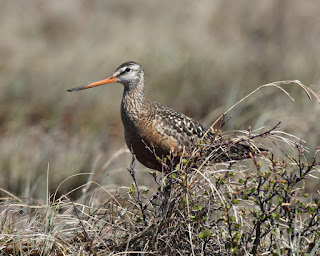It all got kick-started last Saturday when Michael Butler found a Eurasian Dotterel. This is such a crazy bird - just a handful of North American records outside of Alaska (something like 3 California, 1 Washington, 1 Oregon, and 1 British Columbia records). This was obviously pretty exciting but there has been some really interesting other sightings that may all have their origin in the incredibly strong winds we had for several days in a row for the first few days of the month.
 |
| An adult White-rumped Sandpiper in August on James Bay |
 |
| Frequency of eBird reports of White-rumped Sandpipers in s. ON |
 |
| Average count of White-rumped Sandpipers in s. ON |
 |
| A northbound White-rumped Sandpiper in June in Polar Bear PP |
But this October has been anything but ordinary for reports of large flocks of juvenile White-rumped Sandpipers in southern Ontario. Check out this figure:
 |
| Reports by year of flocks of White-rumped Sandpiper of >10 birds |
And it's not just the number of reports that is impressive. Below is a table of the ten highest counts I could find for southern Ontario (using the following data sources: Hamilton Naturalists' Club database, Northumberland County bird database, eBird, Ontario high counts database maintained by George Bryant, and the GTA and Ontario bird records database maintained by Roy Smith).
| Count | Date | Observer | Location, County |
|---|---|---|---|
| 310 | 07/10/2015 | Mike V.A. Burrell |
Exeter Sewage Lagoons, Huron |
| 200 | 14/10/2015 | Dan Macneal | Belwood Lake, Wellington |
| 180 | 07/10/2015 | Jarmo Jalava | Wildwood Reservoir, Oxford |
| 135 | 11/10/2015 | Mike V.A. Burrell et al. |
Mitchell Sewage Lagoons (West Perth Wetlands), Perth |
| 120 | 07/10/2015 | Wayne Renaud | Oliphant, Bruce |
| 120 | 04/10/2015 | Doug McRae | Presqu'ile Provincial Park, Northumberland |
| 120 | 06/10/2015 | Elena Kreuzberg | Ottawa--Shirley's Bay, Ottawa |
| 118 | 04/10/2015 | Jarmo Jalava | Mitchell Sewage Lagoons (West Perth Wetlands), Perth |
| 100 | 10/10/2015 | Mark Patry | Ottawa--Shirley's Bay, Ottawa |
| 92 | 04/10/2011 | Jeff Skevington | Ottawa--Shirley's Bay, Ottawa |
Even if you take out some of the records that are likely the same flock on subsequent days 9 of the top 10 high counts in southern Ontario are from the last 10 days, so it is very apparent that this October really is amazing for this species here. We can speculate that these numbers have resulted from a grounding of the flocks of juvenile White-rumped Sandpipers migrating out of James Bay; maybe it was that incredible wind we had to start the month?
 |
| A Hudsonian Godwit on the breeding grounds in Polar Bear PP |
What I really love about this is it really shows the utility of using eBird to monitor and analyse bird events as they are unfolding - you don't have to wait a year until the seasonal summaries in North American Birds comes out!




